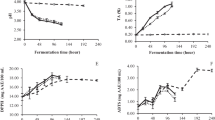Abstract
Lacto-juices processed by lactic acid fermentation bring about a change in the beverage assortment for their high nutritive value, vitamins and minerals which are beneficial to human health when consumed. Sweet potato roots (non-boiled/ fully-boiled) were fermented with Lactobacillus plantarum MTCC 1407 at 28 ± 2°C for 48 h to make lacto- juice. During fermentation both analytical [pH, titratable acidity, lactic acid, starch, total sugar, reducing sugar (g/kg roots), total phenol and β-carotene (mg/kg roots)] and sensory (texture, taste, aroma, flavour and after taste) analyses of sweet potato lacto-juice were evaluated. The fermented juice was subjected to panelist evaluation for acceptability. There were no significant variations in biochemical constituents (pH, 2.2–3.3; lactic acid, 1.19–1.27 g/kg root; titratable acidity, 1.23–1.46 g/kg root, etc.) of lacto-juices prepared from non-boiled and fully-boiled sweet potato roots except β-carotene concentration [130 ± 7.5 mg/kg (fully-boiled roots) and 165 ± 8.1 mg/kg (non-boiled roots)]. The panelist evaluation scores ranged from 3–4.8 (in a hedonic scale of 1–5) from moderate liking to very much liking of sweet potato lacto-juice. Principal component analyses reduced the eight original analytical variables to three independent components (factors), which accounted for 99.9% of the total variations. Similarly, five original sensory variables were reduced to two independent components, which accounted for 83.1% of the total variations.


Similar content being viewed by others
References
Kaur IP, Chopra K, Saini A (2002) Probiotics: Potential pharmaceutical applications. Eur J Pharm Sci 151: 1–9.
Klewicka E, Motyl I, Libudzisz Z (2004) Fermentation of beet juice by bacteria of genus Lactobacillus sp. Eur Food Technol 218: 178–183.
Nychas GJE, Panagou EZ, Parker ML, Waldron KW, Tassou CC (2002) Microbial colonization of naturally black olives during fermentation and associated biochemical activities in the cover brine. Lett Appl Microbiol 34: 173–177.
McFeeters RF (2004) Fermentation microorganisms and flavor changes in fermented food. J Food Sci 69(1): 35–37.
Molin G (2001) Probiotics in foods not containing milk or milk constituents, with special reference to Lactobacillus plantarum 299v. Am J Clin Nutr 73(Suppl): 380S–385S.
Montet D, Loiseau G, Zakhia-Rozis N (2006) Microbial technology of fermented vegetables. In: Ray RC, Ward OP (eds), Microbial Biotechnology in Horticulture, Vol 1. Science Publishers Inc, Enfield, NH, USA, pp 309–343.
Ray RC, Ravi V (2005) Post harvest spoilage of sweet potato in tropics and control measures. Crit Rev Food Sci Nutr 45: 623–644.
Ray RC, Ward OP (2006) Post harvest microbial biotechnology of tropical root and tuber crops. In: Ray RC, Ward OP (eds), Microbial Biotechnology in Horticulture, Vol 1. Science Publishers Inc., Enfield, NH, USA, pp 345–395.
Kaur C, Kapoor HC (2001) Antioxidants in fruits and vegetables- the millenium's health. Int J Food Sci Technol 36: 703–725.
Arvanitoyannis IS, Tzouros NE (2005) Implementation of quality control methods in conjunction with chemometrics toward authentication of dairy products. Crit Rev Food Sci Nutr 45: 231–249.
Semmar N, Jay M, Farman M, Chemli R (2005) Chemotaxonomic analysis of Astragalus caprinus (Fabaceae) based on the flavonic patterns. Biochem Syst Ecol 33(2): 187–200.
Sharpe M, Elisabeth Pyer TF (1996) Identification of the lactic acid bacteria in identification method for Microbiologists part A. In: Gibbs BM, Skinner FA (eds), Academic Press, London and New York, pp 65–79.
Panda SH, Parmanick M, Ray RC (2007) Lactic acid fermentation of sweet potato (Ipomoea batatas L.) into pickles. J Food Process and Presv 31(1): 83--101.
Amerine MA, Ough C (1984) Methods for Analysis of Musts and Wines. Wiley-Inter Science Publication, John Wiley and Sons, New York, pp 447.
Mahadevan A, Sridhar R (1993) Methods in Physiological Plant Pathology, 5th edn. Sivakami Publication, Madras, India.
Cochran WG (1950) Estimation of bacterial densities by means of the “most probable number”. Biometrics 6: 105–116.
Kilcast D, Subramanian P (2000) The Stability and Shelf-life of Food. Woodhead Publishing Ltd, Cambridge, UK.
Cass T (1980) Statistical Methods in Management, Vol 2. Casel Ltd, London, UK.
Kim HY, Min JH, Lee JH, Ji GE (2000) Growth of lactic acid bacteria and Bifidobacteria in natural media using vegetables, seaweeds, grains and potatoes. Food Sci Biotechnol 9: 322–324.
Demir N, Acar J, Sar K, Mutlu M (2001) The use of commercial pectinase in fruit industry. J Food Eng 47: 275–280.
Angelova MB (2007) Microbial pectinases: Application in horticultural industries. In: Ray RC, Ward OP (eds), Microbial Biotechnology in Horticulture, Vol 2. Science Publishers Inc. Enfield, NH, USA, In press.
Gardner NJ, Savard T, Obermeier P, Caldwell G, Champagne CP (2001) Selection and characterization of mixed starter cultures for lactic acid fermentation of carrot, cabbage, beet and onion vegetable mixtures. Int J Food Microbiol 64: 261–275.
Adams MR, Nicolaides L (1997) Review of the sensitivity of different food borne pathogens to fermentation. Food Control 8: 227–239.
Lee CHH (1999) Fermentation of rice using amylolytic Bifidobacterium. Int J Food Microbiol 50: 155–161.
Ogunjobi AA, Adebayo-Tayo BC, Ogunshe AA (2005) Microbiological, proximate analysis and sensory evaluation of processed Irish potato fermented in brine solution. Afr J Biotech 4(12): 1409–1412.
Haralampu SG, Karel M (1982) Kinetic models for moisture dependence of ascorbic acid and β-carotene degradation in dehydrated sweet potato. J Food Sci 48(6): 1872–1873.
Panda SH, Naskar SK, Ray RC (2006) Production, proximate and nutritional evaluation of sweet potato curd. J Food Agric Environ 4(1): 124–127.
Stevens J (1992) Applied multivariate statistics for the social sciences. Lawrence Erlbaum Associates Publishers Inc., Hillsdale, NJ, USA.
Karovićovă J, Kohajdovă Z (2002) The use of PCA, FA, CA for the evaluation of vegetable juices processed by lactic acid fermentation. Czech J Food Sci 20(4): 135–143.
Mayne ST (1996) β-carotenoids and disease prevention in humans. FASEB J 10: 690–701.
Acknowledgments
The authors thank Dr S. Edison, Director of CTCRI, for valuable suggestions and facilities.
Author information
Authors and Affiliations
Corresponding author
Rights and permissions
About this article
Cite this article
Panda, S.H., Ray, R.C. Lactic Acid Fermentation of β-Carotene Rich Sweet Potato (Ipomoea batatas L.) into Lacto-juice. Plant Foods Hum Nutr 62, 65–70 (2007). https://doi.org/10.1007/s11130-007-0043-y
Received:
Accepted:
Published:
Issue Date:
DOI: https://doi.org/10.1007/s11130-007-0043-y




